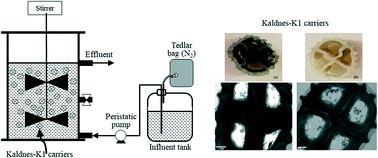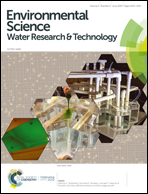Long-term performance evaluation of an anoxic sulfur oxidizing moving bed biofilm reactor under nitrate limited conditions†
Abstract
An anoxic sulfur-oxidizing moving bed biofilm reactor (MBBR) treating sulfur and nitrate-contaminated synthetic wastewater was monitored for 306 days under feed nitrogen-to-sulfur (N/S) molar ratios of 0.5, 0.3 and 0.1. Thiosulfate (S2O32−) removal efficiencies (RE) exceeding 98% were observed at a N/S ratio of 0.5 and a S2O32− loading rate of 0.9 g S2O32−–S L−1 d−1, whereas a RE of 82.3 (±2.6)% and 37.7 (±3.4)% were observed at N/S ratios of 0.3 and 0.1, respectively. Complete nitrate (NO3−) removal was obtained at all tested N/S ratios. A comparison of the kinetic parameters of the MBBR biomass under the same stoichiometric conditions (N/S ratio of 0.5) revealed a 1.3-fold increase of the maximum specific rate of S2O32− oxidation (rmax) and a 30-fold increase of the affinity constant for S2O32− (Ks) compared to those observed after long-term NO3− limitation (N/S ratio of 0.1). The MBBR showed optimal resilience to NO3− limitation as the S2O32− RE recovered from 37.3% to 94.1% within two days after increasing the N/S ratio from 0.1 to 0.5. Based on PCR-DGGE analysis, sulfur-oxidizing nitrate-reducing bacteria, i.e. Thiobacillus sp. and Sulfuritalea sp., dominated in the MBBR biofilm during the entire study.



 Please wait while we load your content...
Please wait while we load your content...